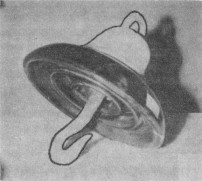Porcelain Insulator News
by Jack H. Tod, NIA #13
Reprinted from "INSULATORS - Crown Jewels of the Wire", February 1979, page 30
Dear Jack:
I bought these two insulators from an old man
who retired from the power company 30 years ago and has had them ever since. He
had hauled many of his insulators to the dump a couple of years ago.
The
suspension insulator is almost black metallic with orange and cream colored
streaks, and it certainly is beautiful. With the hook in the bottom, one could
almost use this for a fishing anchor.

The front marking on the iron cap is: G /
5561 / THOMAS. On the back: U.S. PAT / 11-19-18 / 11-30-20 / MADE IN / U.S.A.
I'm not sure if the first patent year is 1918 or 1913. The overall insulator
diameter is 7-1/4".
What can you tell me about this insulator, and do you
know what the square G on the front stands for?

This large strain insulator
(7" tall) isn't only beautiful, but simply gorgeous. It's a beautiful beige
to caramel brown with the shiniest black and orange streaks. There is a recessed
marking close to the bottom on one of the ridges, but I cannot tell what it is,
This is the largest strain insulator I have in my collection. Do you have in any
of your books information on these types of insulators? The only one of your
books I have is the 2nd Edition of your Porcelain Insulators Guide Book on pin
types, and I almost have it worn out. Sure is a good book.
We sure hated to miss
the NIA National in Reno last summer. However, I'm planning to exhibit at the
NIA National in Denver this July. I can hardly wait. Being historian for the NIA
is very Interesting, exciting and educational. I had no idea that so much has
gone into the insulator hobby and collecting the past 10 years, and how the
National Insulator Association has grown and progressed in the past 5 years, The
permanent NIA scrapbooks are fantastic reading. I'll sure be happy to meet many
new faces at Denver, my first National show.
Carolyn Theesen, NIA #1590
Lawton,
Okla.
- - - - - - - - -
Dear Carolyn:
The presence of the patent markings on your Thomas
suspension disk probably means it's an early item, even though this general
style was cataloged to 1940 at least. The fact that all patent dates are
Tuesdays indicates the correct date is 11-19-18, not 1913. By the way, my book
"Electrical Porcelain" has an appendix page which shows the dates of
all Tuesdays from 1836 through the year 2000.
Your very large strain must be a
real beauty, and the glaze type sounds like Ohio Brass Company from years ago.
The design exactly fits an O-B design patent (#59,947) of 12-13-21.
No, none of
my books (or those of others) list these types of insulators in such a way you
could attribute them as to manufacturer or vintage etc. We just describe the
general insulator types and their use and let it go at that. The only insulator
types which are covered in great detail are pin types, and that's because those
are so universally collected in a big way. Sure you understand.
My book
"Electrical Porcelain" is a specialized book on house wiring
insulators and related types and is essentially devoid of descriptive info on
poleline insulators. It does have 56 pages of tabulations and descriptions of
nearly all patents (about 700) of potential interest to insulator collectors,
including all those relating to glass and porcelain pin types. Some people
have obtained the book for the patent section alone.
At one time (long ago!) I
contemplated researching and publishing a volume on all forms of poleline
insulators other than pin types, but such thoughts became an exercise in
futility. It would require thousands of hours of time and considerable travel.
Publishing costs alone would be at least 10 times the possible gross book sales
(either 100 books at $5, or 10 books at $50).
By the way, Carolyn, the guys once
accused me of being selectively derisive by referring to certain very large
insulators as being useful as boat anchors, so I must point out that you used
that term above. T'weren't me. Besides, if I used that, hook-suspension for an
anchor in the little lake where I fish, I'd be permanently snagged on that
bottom and would have to cut the anchor rope. For my trout lake and size of
boat, a 10" Hewlett-type suspension is just about perfect.
Jack
| 